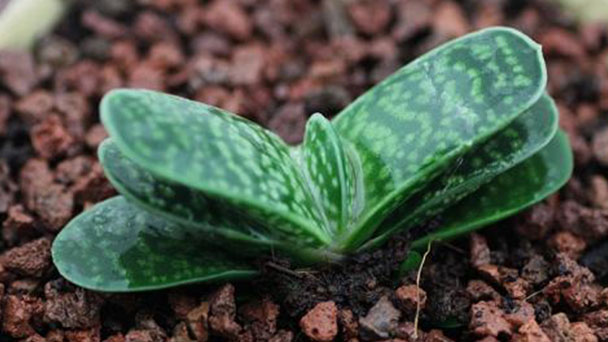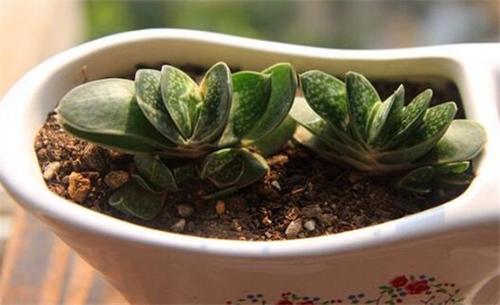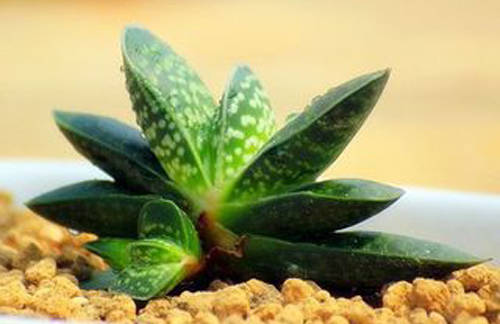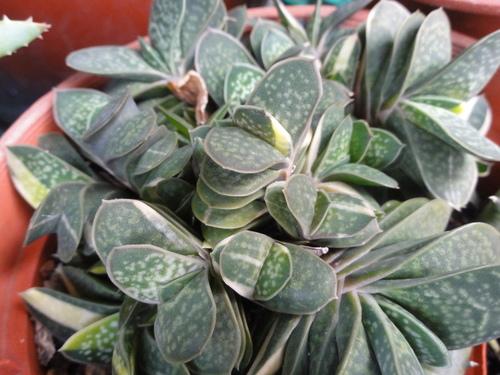Gasteria Gracilis Baker profile
Written by Maggie
Mar 16 2021

Gasteria Gracilis Baker belongs to the genus Palmatum in the Family Apodidae. Gasteria Gracilis Baker looks like ingot, which is a kind of succulent plant common in the domestic flower market. Leaves are thick, fleshy, liquid, glossy, with white spots.
Gasteria Gracilis Baker picture

Gasteria Gracilis Baker morphological characteristics
Gasteria Gracilis Baker leaves have thick fleshy texture, like tongue, smooth leaves with white spots. There are varieties of brocade spot in the same species, with white stripes appearing in the middle of the leaves, which are relatively prone to brocade spot variation.
The leaves of gasteria plant are 2~5 cm long and 1~2.5 cm wide, and red after exposure to the sun. The leaves of Gasteria Gracilis Baker are beautiful, with and without brocade, the common ones are all green, without brocade. There are two kinds of color above for the belt brocade, called the child treasure brocade. The color is different, and each has its own characteristics.
Flower stems are from the tongue root of leaves, flowers are small, mostly red green. General winter to spring for flowering season.
Gasteria Gracilis Baker growing environment
Gasteria Gracilis Baker likes semi-overcast and well-ventilated places. Too much sunshine will make the original green leaves become deeper, and loose and fertile sandy loam with good drainage is preferred as the cultivation substrate. If conditions permit, the basin soil used can be prepared from rotten leaves, fine sand and garden soil. Relatively cold resistant, overwintering temperature is not less than 5℃. In summer, it can not be exposed to the sun. The sun will burn gasteria gracilis Baker, sunburn and thin leaves, not fresh green and other poor growing conditions.

How to grow and care for Gasteria Gracilis Baker
1. Environment care
The optimum temperature for growth of succulent Gasteria Gracilis Baker is between 16 ℃ and 28℃. If the temperature is higher than 35℃ in summer, gasteria gracilis baker plants will stop growing and shed leaves.
If the temperature is lower than 10℃ in winter, Gasteria Gracilis Baker will also enter a dormant state, and the buds will fall off easily.
2. Soil care
Gasteria Gracilis Baker prefers loose, fertile, well-drained sandy loam soils, so home potting soils can be made from a mixture of leaf rot, fine sand, garden soil, and perlite.
In addition, organic fertilizers can be added to the soil to help Gasteria Gracilis Baker grow.
3. Lighting care
Gasteria Gracilis Baker likes a sunny environment, and tries to put enough light on the balcony, window sill and other places during daily maintenance. When the temperature is relatively high from summer to autumn, Gasteria Gracilis Baker can be maintained in a semi-shady and ventilated place to avoid direct exposure to strong light.
If Gasteria Gracilis Baker is kept in shade for long periods of time, artificial lighting is needed.
4. Watering care
Gasteria plant is a succulent plant that is afraid of water and rain. Drainage and shelter should be done during the rainy season, and water should not be used during the rainy season.
Gasteria Gracilis Baker lives long in the spring and fall, so flood every other week or so. Water every 20-30 days in summer and 30-40 days in winter.
5. Fertilization care
Gasteria Gracilis Baker is growing in the spring and fall, and florists can fertilize it once a month with extra nitrogen. Fertilization should be stopped during high summer temperatures or low winter temperatures.
Gasteria Gracilis Baker distribution range
Gasteria Gracilis Baker is native to South Africa and is cultivated in many parts of the world.
The main value of Gasteria Gracilis Baker
Gasteria Gracilis Baker leaf shape leaf color is beautiful, which has certain ornamental value.
Gasteria Gracilis Baker plant is young, grows slower, rich characteristic, variety is diverse, appropriate uses small potted plant, displays at windowsill, desk, desk, balcony,, and it is a more ideal table grown plant.
Gasteria Gracilis Baker soil selection
Loose and fertile sandy loam should be selected as the culture substrate. If possible, the basin-soil may be composed of leaf rot, fine sand and garden soil in a ratio of 0.5:2:1 by volume. Gasteria Gracilis Baker is small and delicate, usually transplanting in small pots. Gasteria Gracilis Baker prefers a dry soil environment, very drought tolerant, except in the vigorous growth stage watering once a week. In the cold season of winter and spring, water intervals should be controlled once every half a month, otherwise the plants will rot easily and eventually die. During the vigorous growth stage, the rarefied liquid fertilizer should be applied once every 10 days. Gasteria Gracilis Baker prefers a sunny environment. Avoid too much shade, or the plants will grow in vain. It prefers warm and does not tolerate cold. It grows well in the temperature range of 16℃ ~ 26℃. Winter and spring season due to the low ambient temperature, plant growth is very slow, this is a normal phenomenon, and there is no need to worry. The overwintering temperature should not be lower than 5℃. In balcony cultivation, the Gasteria Gracilis Baker's paw is usually not susceptible to disease and rarely attacked by harmful animals. The big plant should be turned over once every spring for more than three years.

Latest Updated
- Benefits of Bugleweed - 7 Science-backed Health Benefits
- Bugleweed Dangers & Side Effects - Is It Poisonous?
- How to Plant Evergreen Trees - What You Should Know
- When to Plant Evergreens - Grow Guide for Evergreen Trees
- 12 Wonderful Evergreen Shrubs for Your Garden
- 12 Popular Evergreen Plants with Pictures for Beginners
- When And How To Prune A Lilac Bush Like a Pro
- How to Grow & Care for Lilac Vine (Hardenbergia Violacea)
- Japanese Lilac Tree (Syringa Reticulata) Care & Propagation Guide
- Shumard Oak Pros and Cons - What to Know
Popular Articles
- Winter maintenance of Antirrhinum Majus
- How to Grow Terminalia Mantaly Tree
- How to Grow and Care for Crossostephium Chinense
- How to grow Antirrhinum Majus in spring
- Peristeria Elata (Dove Orchid) Profile: Info & Care Guide
- Underwatered Snake Plant (Sansevieria Trifasciata) - Signs And How To Fix
- How to Care for Brazilian Jasmine Plant (Mandevilla Sanderi)
- How to Grow & Care for Graptopetalum Purple Delight in Summer
- Rosa Chinensis (China Rose): Plant Growing & Care Tips
- How to Care for Baby Sun Rose (Aptenia Cordifolia)